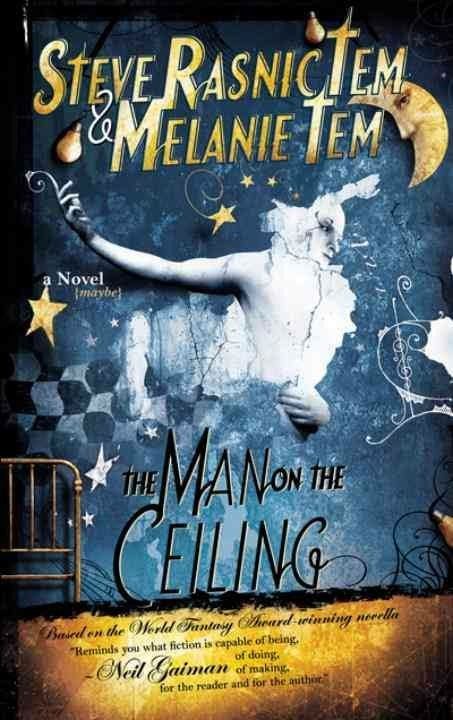Everything we’re about to tell you here is true.
That’s how The Man on the Ceiling, the dark fantasy/horror/memoir by Steve Rasnic Tem and Melanie Tem, begins. At first, it seems like a common device: the authors are writing about their lives and their family, their “protagonists” are named Steve and Melanie, and while there are a bunch of things that are probably fictionalized, the lines between fiction and reality are suitably blurry through a lot of the book, compounded by how the Tems tend to talk about the stories they tell themselves. There are times where that phrase, “everything we’re telling you is true,” seems like a jab at the reader, usually when the authors are talking about someone believing the stories they tell. But they’re never being any less than honest– everything, even the most farfetched things like Steve chasing a sentient shadow monster around the house with a flashlight, the brief moment where Melanie’s family and house disappear, and Steve talking to a version of his son perched on his roof like a gargoyle. It might not all be factual, some of it might be fictional, but all of it, every last word, is true. And it’s that commitment to the truth, the emotional truth and the belief that there’s an underlying truth to all the stories, that gives the book its power and, at times, makes it kind of terrifying.
For those who haven’t read the book, The Man on the Ceiling is about Steve and Melanie Tem, their four children, and their grandchildren. One night, as Steve and Melanie have a vision of a shadowy man-shaped thing on the ceiling visiting them and their family, getting into their heads and touching off a series of vignettes blurring the lines between the absolute reality and the supernatural, jumping from story to story in an associative way, each new memory building on the old and flowing from theme to theme, creating a sometimes disjointed but beautiful family portrait about love and loss.

It’s more honest that the book is associative. Memory isn’t a static or chronological thing, after all, it leaps and jumps and creates unexpected ties between things, sometimes moving backwards and forwards through time, never in a straight line. By telling the story through shorter segments, alternating between Steve and Melanie as they tell their own stories about various events and occasionally overlap, it makes it feel more like real recollections. Even the way the individual events play out in a kind of surreal fashion makes it seem like a dream based on real things that happened, or like a half-remembered memory. It’s one of the things that allows the book to transition between the fantastical and the real, gives it a feeling of slight disorientation, but also the sense that this is something familiar. After all, if real memories jump around and draw lines between each other, and call backward and forward, why shouldn’t a book about them? It also helps draw the reader in, make everything feel that much more real, which lets the emotional punches of the book hit harder.
The Man on the Ceiling is heavily rooted in the real. Even if the Tems are fictionalized versions of themselves, and even if there’s not an evil shadow-spirit leaching into souls and causing misfortune, there’s always the feeling when things go wrong that something is casting a shadow over your life, that there’s some kind of malign presence causing things to go horribly wrong. Reality might not “puddle,” but there are times when things get out of control and you have to kind of wait for the world around you to reassert itself, for your life to come back to you. These are all real emotions, real feelings that the Tems build their story around. It’s actually how the book derives most of its horror. The threat is never monsters or the supernatural, but the thought of Melanie losing her family, Steve losing his memories, the death of loved ones, the idea that the people you love will go away, or even the simple inability to get close to people, all played up and shifted slightly. It’s horror you can connect to, even if it’s made slightly fantastical with death being a creepy classic car in the woods, or again with the ever-present man in the ceiling, things seasoned with just enough common fear to be real.
But even when it does get fantastical, it’s all grounded in a sort of common understanding. Everyone’s seen the shadows on the walls or ceiling of their room at night, twisted into unnatural shapes and possibly moving on their own. Everyone has their own nightmares about what could possibly go wrong, about the way the people you love and care about might hurt you, might suddenly vanish out of your lives. The things that terrorize the Tems speak to things everyone’s afraid of, or use images that most people can hook into, making them feel more real even as they’re unique to the story of Steve and Melanie. It touches at the underlying truth that people are more or less afraid of the same things, or the same versions of things, and helps sell the more terrifying and melancholy moments of the book. Those fantastical and horror-flavored elements also touch on something very few writers do– life is incredibly strange, and sometimes odd things happen that we can’t explain, or things happen that are out of the ordinary. While we can certainly explain this away (and many of us do), or convince ourselves that maybe we didn’t see or hear what we thought we did, things like the man on the ceiling or weird reality puddles or conversations with supernatural beings still stick with us. All The Man on the Ceiling does is present those things as real, and more or less true. The fiction is a device that allows those unusual events that happen to the Tems, and happen to us, to be seen as a little more real.
It’s the underpinnings of the real, that grounding in emotional truth, that allows The Man on the Ceiling to resonate. No, not everything here is factual– some of it’s fictionalized, some of it is more fantastical than others, and some of it is just surreal enough to be a weird blip, to make you lose a step wondering if what happened just happened. But all of it speaks to something on a deeper emotional level, a certain truth we all kind of know. It’s something anyone who reads The Man on the Ceiling will be able to connect with, to find their own memories and recognize the weird events in their lives, to deal with our own weird spirits and unusual fears. It’s scary, sure, but it’s scary the way life is scary, because there are things that might happen to us, and things that will. It’s scary because those who read the story know there’s some truth to all of this. Even if it’s not factual.
It’s scary because everything they’re telling you is true.



